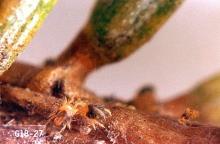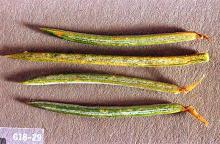Oligonychus ununguis and others
Pest description and crop damage Dark green mite stipples and bronzes needles, beginning at the base. Overwinters as red-orange eggs.
Management-chemical control
- abamectin (Avid, Minx and others) (Group 6) -Some abamectin formulations are restricted use pesticides.
- azadirachtin (AzaDirect and others)-Some formulations are OMRI-listed for organic production.
- bifenazate (Acramite 4SC, Floramite SC, and others) (Group 20)
- bifenthrin (OnyxPro, Sniper and others) (Group 3)-Restricted use pesticide.
- Chromobacterium subtsugae (Grandevo)-OMRI-listed for organic use.
- clofentezine (Apollo SC and others) (Group 10)
- etoxazole (TetraSan 5 WDG and others) (Group10)
- fenazaquin (Magister and others) (Group 21)
- fenbutatin-oxide (Vendex and others) (Group12b)-Restricted use pesticide.
- fenpyroximate (Akari 5 SC and others) (Group 21)
- hexythiazox (Onager, Hexygon, Savey) (Group 10)
- insecticidal soaps and oils (Ecotec, Captiva, M-pede, Ultra-Pure Oil, 440 Superior [Winter only] and others)-Test for phytotoxicity for any new oil product prior to widespread use. Some formulations are OMRI- listed for organic production.
- malathion (organophosphate) (various formulations) (Group 1B)
- propargite (Omite-30WS, Omite 6E) (Group 12)-Restricted use pesticide
- spinosad (Blackhawk, Conserve, Entrust and others) (Group 5)
- spirodiclofen (Envidor) (Group 23)
Management-biological control
Predatory mites (Neoseiulus spp., Phytoseilulus spp. and others)-Note: Little information is available on the efficacy of releasing predatory mites but control in plantations from native populations is common.
See:


